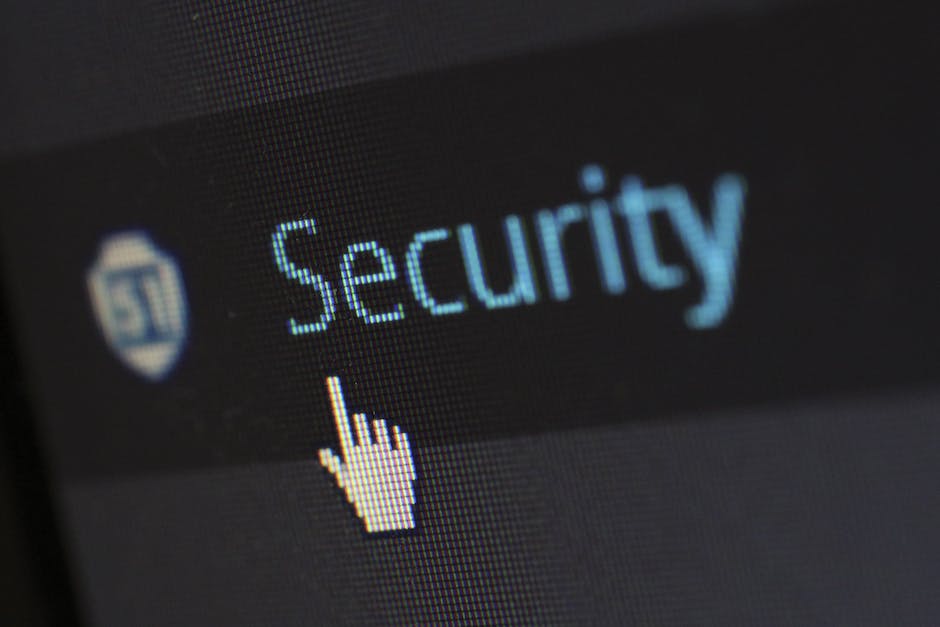Table of Contents
“Protecting Today’s Digital World, Leading Tomorrow’s Success”
Introduction
Introduction:
Cybersecurity has become a crucial aspect of modern leadership. In today’s digital age, organizations and individuals are increasingly reliant on technology, making them vulnerable to cyber threats. As a result, leaders must prioritize cybersecurity to protect sensitive information, maintain trust, and ensure the continuity of operations. This introduction will explore the significance of cybersecurity in modern leadership, highlighting its role in safeguarding against cyberattacks, mitigating risks, and fostering a secure digital environment.
The Importance of Cybersecurity in Leadership Roles

In today’s digital age, cybersecurity has become a crucial aspect of modern leadership. With the increasing reliance on technology and the rise of cyber threats, leaders in all industries must prioritize cybersecurity to protect their organizations and stakeholders. This article will explore the importance of cybersecurity in leadership roles and highlight the key reasons why leaders should make it a top priority.
First and foremost, leaders have a responsibility to safeguard their organizations from cyber threats. Cyberattacks can have devastating consequences, ranging from financial losses to reputational damage. Leaders who neglect cybersecurity put their organizations at risk of data breaches, intellectual property theft, and operational disruptions. By prioritizing cybersecurity, leaders can mitigate these risks and ensure the continuity and stability of their organizations.
Furthermore, cybersecurity is essential for maintaining customer trust and loyalty. In today’s interconnected world, customers expect their personal information to be protected when they interact with organizations online. A single data breach can erode customer trust and lead to a loss of business. Leaders who prioritize cybersecurity demonstrate their commitment to protecting customer data and can differentiate themselves from competitors who neglect this crucial aspect of business.
Moreover, cybersecurity is closely linked to regulatory compliance. Many industries, such as finance and healthcare, are subject to strict data protection regulations. Leaders who fail to comply with these regulations not only face legal consequences but also risk damaging their organizations’ reputation. By prioritizing cybersecurity, leaders can ensure compliance with relevant laws and regulations, thereby avoiding costly penalties and maintaining a positive image in the eyes of regulators and stakeholders.
In addition to external threats, leaders must also be aware of internal vulnerabilities. Insider threats, whether intentional or unintentional, can pose significant risks to organizations. Employees with access to sensitive information can inadvertently leak data or intentionally misuse it for personal gain. Leaders who prioritize cybersecurity can implement robust access controls, employee training programs, and monitoring systems to detect and prevent insider threats. By fostering a culture of cybersecurity awareness, leaders can empower their employees to become the first line of defense against cyber threats.
Furthermore, cybersecurity is not just a technical issue; it is a strategic imperative. Leaders who understand the potential impact of cyber threats on their organizations can make informed decisions and allocate resources effectively. By integrating cybersecurity into their strategic planning processes, leaders can identify and prioritize the most critical assets and vulnerabilities, develop incident response plans, and allocate resources to mitigate risks. This proactive approach to cybersecurity enables leaders to stay ahead of emerging threats and minimize the potential impact on their organizations.
In conclusion, cybersecurity is a crucial aspect of modern leadership. Leaders must prioritize cybersecurity to protect their organizations from external threats, maintain customer trust, comply with regulations, mitigate insider risks, and make informed strategic decisions. By recognizing the importance of cybersecurity and taking proactive measures to address it, leaders can ensure the long-term success and resilience of their organizations in an increasingly digital world.
Strategies for Implementing Effective Cybersecurity Measures
Strategies for Implementing Effective Cybersecurity Measures
In today’s digital age, cybersecurity has become a crucial aspect of modern leadership. With the increasing reliance on technology and the ever-growing threat of cyber attacks, organizations must prioritize the implementation of effective cybersecurity measures. This article will explore some strategies that leaders can employ to safeguard their organizations against cyber threats.
First and foremost, leaders must recognize the importance of creating a culture of cybersecurity within their organizations. This involves fostering an environment where employees are educated about the risks and consequences of cyber attacks and are encouraged to take proactive measures to protect sensitive information. By promoting a culture of cybersecurity, leaders can ensure that every individual within the organization understands their role in safeguarding data and is equipped with the necessary knowledge and tools to do so.
Another crucial strategy is to regularly assess and update the organization’s cybersecurity infrastructure. This involves conducting thorough risk assessments to identify vulnerabilities and potential entry points for cyber attacks. By staying up to date with the latest security technologies and best practices, leaders can ensure that their organizations are well-prepared to defend against evolving cyber threats. Regularly updating software, implementing strong firewalls, and encrypting sensitive data are just a few examples of measures that can significantly enhance an organization’s cybersecurity posture.
Furthermore, leaders must prioritize the training and education of their employees in cybersecurity practices. Many cyber attacks are successful due to human error, such as falling victim to phishing scams or using weak passwords. By providing comprehensive training programs and workshops, leaders can empower their employees to make informed decisions and adopt secure practices in their day-to-day activities. Additionally, leaders should encourage a continuous learning mindset, as cyber threats are constantly evolving, and staying ahead of the curve is essential.
Collaboration and information sharing are also vital strategies for effective cybersecurity. Leaders should actively engage with industry peers, government agencies, and cybersecurity experts to exchange knowledge and best practices. By participating in forums, conferences, and information-sharing initiatives, leaders can gain valuable insights into emerging threats and innovative solutions. Collaboration also extends to partnerships with cybersecurity vendors and service providers, who can offer specialized expertise and technologies to enhance an organization’s security posture.
In addition to these strategies, leaders must also establish robust incident response plans. Despite the best preventive measures, cyber attacks can still occur. Having a well-defined and tested incident response plan in place ensures that the organization can respond swiftly and effectively to minimize the impact of a breach. This includes clear communication channels, designated response teams, and predefined steps to contain and mitigate the attack. Regular drills and simulations can help identify any gaps in the plan and allow for continuous improvement.
Lastly, leaders must lead by example when it comes to cybersecurity. By demonstrating a commitment to cybersecurity practices themselves, leaders can set the tone for the entire organization. This includes adhering to secure password policies, practicing safe browsing habits, and being vigilant against potential threats. When employees see their leaders taking cybersecurity seriously, they are more likely to follow suit and prioritize it in their own work.
In conclusion, implementing effective cybersecurity measures is a crucial responsibility for modern leaders. By creating a culture of cybersecurity, regularly assessing and updating infrastructure, providing comprehensive training, fostering collaboration, establishing incident response plans, and leading by example, leaders can significantly enhance their organization’s ability to defend against cyber threats. In an increasingly interconnected world, effective cybersecurity is not just a technical concern but a fundamental aspect of successful leadership.
Cybersecurity Challenges Faced by Modern Leaders
In today’s digital age, cybersecurity has become a crucial aspect of modern leadership. As technology continues to advance, so do the threats and challenges that leaders face in protecting their organizations from cyber attacks. From data breaches to ransomware attacks, the consequences of a cybersecurity breach can be devastating, both financially and reputationally. Therefore, it is imperative for modern leaders to understand and address the cybersecurity challenges that they face.
One of the biggest cybersecurity challenges faced by modern leaders is the ever-evolving nature of cyber threats. Hackers are constantly finding new ways to exploit vulnerabilities in systems and networks, making it difficult for leaders to stay one step ahead. This requires leaders to be proactive in their approach to cybersecurity, constantly updating their systems and implementing the latest security measures to protect their organizations.
Another challenge is the increasing complexity of technology. With the rise of cloud computing, mobile devices, and the Internet of Things (IoT), leaders are faced with the task of securing a vast and interconnected network of devices and systems. This complexity makes it more difficult to identify and address vulnerabilities, as well as to ensure that all devices and systems are properly protected.
Additionally, leaders must also contend with the challenge of employee negligence or malicious intent. Studies have shown that a significant number of cybersecurity breaches are caused by human error, such as clicking on phishing emails or using weak passwords. Leaders must therefore invest in training and education programs to ensure that employees are aware of the risks and best practices for cybersecurity.
Furthermore, leaders must also navigate the challenge of balancing security with usability. While implementing stringent security measures may help protect against cyber threats, it can also hinder productivity and user experience. Leaders must find the right balance between security and usability, ensuring that their systems are secure without impeding the day-to-day operations of their organization.
Another challenge faced by modern leaders is the increasing regulatory landscape surrounding cybersecurity. Governments around the world are enacting stricter regulations to protect sensitive data and hold organizations accountable for breaches. Leaders must stay informed about these regulations and ensure that their organizations are in compliance, or risk facing severe penalties.
Lastly, leaders must also consider the challenge of limited resources. Cybersecurity can be a costly endeavor, requiring investments in technology, personnel, and training. However, many organizations, especially smaller ones, may not have the financial resources to implement robust cybersecurity measures. Leaders must therefore find creative solutions to address this challenge, such as partnering with cybersecurity firms or leveraging open-source tools.
In conclusion, cybersecurity is a crucial aspect of modern leadership, and leaders must be prepared to address the challenges that come with it. From the ever-evolving nature of cyber threats to the complexity of technology and the human factor, leaders must be proactive in their approach to cybersecurity. They must find the right balance between security and usability, stay informed about regulatory requirements, and find creative solutions to overcome resource limitations. By doing so, leaders can protect their organizations from cyber attacks and ensure the continued success and reputation of their businesses.
The Role of Leadership in Creating a Cybersecurity Culture
In today’s digital age, cybersecurity has become a crucial aspect of modern leadership. With the increasing reliance on technology and the ever-present threat of cyber attacks, leaders must take proactive measures to protect their organizations and ensure the safety of sensitive information. One of the key responsibilities of leaders is to create a cybersecurity culture within their organizations, where every employee understands the importance of cybersecurity and actively participates in safeguarding against potential threats.
Creating a cybersecurity culture starts with leadership setting the tone from the top. Leaders must demonstrate a commitment to cybersecurity and make it a priority within the organization. This involves allocating resources, such as budget and personnel, to implement robust cybersecurity measures. By investing in cybersecurity, leaders send a clear message to their employees that protecting the organization’s data and systems is of utmost importance.
Furthermore, leaders must lead by example. They should adhere to cybersecurity best practices themselves and encourage their employees to do the same. This includes regularly updating passwords, using multi-factor authentication, and being cautious when clicking on suspicious links or downloading files. When leaders demonstrate a strong commitment to cybersecurity, it sets the standard for the entire organization.
Another crucial aspect of creating a cybersecurity culture is providing ongoing training and education to employees. Many cyber attacks occur due to human error, such as falling for phishing scams or unknowingly downloading malware. By educating employees about common cyber threats and how to identify and respond to them, leaders can significantly reduce the risk of successful attacks. Training sessions, workshops, and regular communication about cybersecurity best practices can help employees stay vigilant and make informed decisions when it comes to protecting sensitive information.
Leaders should also foster a culture of open communication and encourage employees to report any suspicious activities or potential security breaches. This can be achieved by establishing clear channels for reporting incidents and ensuring that employees feel comfortable speaking up without fear of retribution. By creating a safe and supportive environment, leaders can empower their employees to be proactive in identifying and addressing potential cybersecurity threats.
In addition to creating a cybersecurity culture within their own organizations, leaders must also collaborate with external stakeholders to enhance cybersecurity measures. This includes partnering with industry experts, government agencies, and other organizations to share information and best practices. By staying informed about the latest cyber threats and collaborating with others, leaders can stay one step ahead of potential attackers and better protect their organizations.
In conclusion, creating a cybersecurity culture is a crucial aspect of modern leadership. Leaders must set the tone from the top, demonstrate a commitment to cybersecurity, and lead by example. Ongoing training and education for employees, fostering open communication, and collaborating with external stakeholders are also essential in creating a strong cybersecurity culture. By prioritizing cybersecurity and actively involving employees in safeguarding against potential threats, leaders can protect their organizations and ensure the safety of sensitive information in today’s digital landscape.
Q&A
1. Why is cybersecurity important in modern leadership?
Cybersecurity is important in modern leadership because it protects sensitive information, prevents data breaches, and safeguards against cyber threats that can disrupt operations and damage reputation.
2. What are the potential consequences of neglecting cybersecurity in leadership?
Neglecting cybersecurity in leadership can lead to data breaches, financial losses, legal liabilities, damage to reputation, loss of customer trust, and disruption of business operations.
3. How can leaders prioritize cybersecurity in their organizations?
Leaders can prioritize cybersecurity by implementing robust security measures, conducting regular risk assessments, providing cybersecurity training to employees, staying updated on the latest threats, and allocating sufficient resources to maintain a strong cybersecurity posture.
4. What role does leadership play in creating a cybersecurity culture?
Leadership plays a crucial role in creating a cybersecurity culture by setting the tone from the top, promoting awareness and accountability, fostering a culture of continuous learning and improvement, and integrating cybersecurity into the organization’s overall strategy and decision-making processes.
Conclusion
In conclusion, cybersecurity has become a crucial aspect of modern leadership. With the increasing reliance on technology and the growing threat of cyber attacks, leaders must prioritize cybersecurity measures to protect their organizations, stakeholders, and sensitive data. By implementing robust security protocols, fostering a culture of awareness and education, and staying updated on the latest threats and technologies, leaders can effectively mitigate risks and ensure the long-term success and resilience of their organizations in the digital age.




